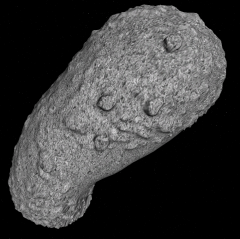Difference between revisions of "25143 Itokawa"
(25143 Itokawa.) |
(Adding content.) |
||
| (4 intermediate revisions by the same user not shown) | |||
| Line 2: | Line 2: | ||
!bgcolor="lightsteelblue" colspan="2" align="center" |25143 Itokawa | !bgcolor="lightsteelblue" colspan="2" align="center" |25143 Itokawa | ||
|- | |- | ||
| − | |colspan="2" align="center"|[[Image: | + | |colspan="2" align="center"|[[Image:Ikotawa.png|240px]] |
|- | |- | ||
|colspan="2" align="center"|'''Ikotawa in Orbiter''' | |colspan="2" align="center"|'''Ikotawa in Orbiter''' | ||
| Line 57: | Line 57: | ||
|2=[[List of add-ons by T1234|T1234]] | |2=[[List of add-ons by T1234|T1234]] | ||
|3=2014-11-06 | |3=2014-11-06 | ||
| − | |4= | + | |4= All versions |
}} | }} | ||
'''25143 Itokawa''' is a Near-Earth object discovered in 1998 by [[w:Lincoln Near-Earth Asteroid Research|LINEAR]] project and named for the Japanese rocket engineer [[w:Hideo Itokawa|Hideo Itokawa]]. | '''25143 Itokawa''' is a Near-Earth object discovered in 1998 by [[w:Lincoln Near-Earth Asteroid Research|LINEAR]] project and named for the Japanese rocket engineer [[w:Hideo Itokawa|Hideo Itokawa]]. | ||
| + | |||
| + | ==Itokawa in Orbiter== | ||
| + | Itokawa is a Near-Earth object released by T1234 in the add-on 3D Asteroids in November 2014. Modeled as a 45 km body in an eccentric orbit of .28 with a Semimajor axis of about 1.3 AU, it is considerably larger than the actual Itokawa which is about 330 meters average diameter. | ||
| + | |||
| + | The hard landing surface is very much below the visual surface, anywhere from about 30 km to 100 km below. It is modeled at a elongated object with a rough surface. | ||
| + | |||
| Line 67: | Line 73: | ||
Animation of 25143 Itokawa orbit.gif|Animation of the orbit of 25143 Itokawa | Animation of 25143 Itokawa orbit.gif|Animation of the orbit of 25143 Itokawa | ||
</gallery> | </gallery> | ||
| + | |||
| + | {{SolarSystem}} | ||
| + | |||
| + | [[Category:Articles|Ikotawa]] | ||
| + | [[Category:Celestial bodies|Ikotawa]] | ||
| + | [[Category:Solar System|Ikotawa]] | ||
| + | [[Category:Near-Earth objects|Ikotawa]] | ||
Latest revision as of 13:02, 29 May 2024
|
Project home: 3D Asteroids |
25143 Itokawa is a Near-Earth object discovered in 1998 by LINEAR project and named for the Japanese rocket engineer Hideo Itokawa.
Itokawa in Orbiter[edit]
Itokawa is a Near-Earth object released by T1234 in the add-on 3D Asteroids in November 2014. Modeled as a 45 km body in an eccentric orbit of .28 with a Semimajor axis of about 1.3 AU, it is considerably larger than the actual Itokawa which is about 330 meters average diameter.
The hard landing surface is very much below the visual surface, anywhere from about 30 km to 100 km below. It is modeled at a elongated object with a rough surface.
Gallery[edit]
| edit The Solar System | |
|---|---|
| Central star |
Sun (Sol) |
| Planets |
Mercury - Venus - Earth - Mars - Jupiter - Saturn - Uranus - Neptune |
| Natural satellites |
Moon - Phobos - Deimos - Io - Europa - Ganymede - Titan - more... |
| Add-ons |
Planets - Dwarf Planets - Small objects - Natural satellites - Alternative star systems |

